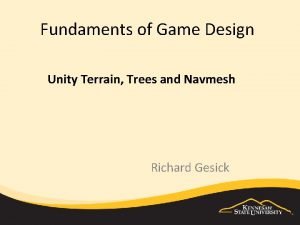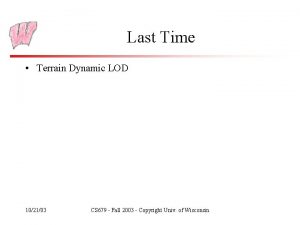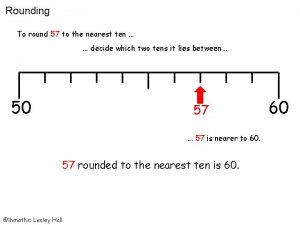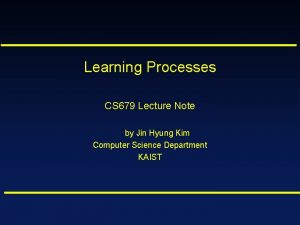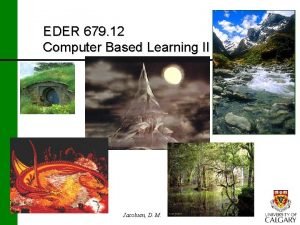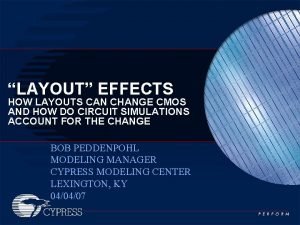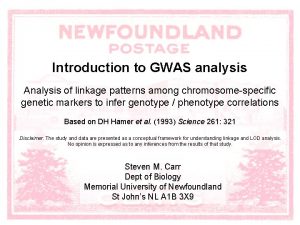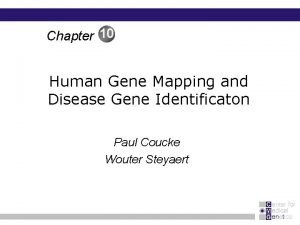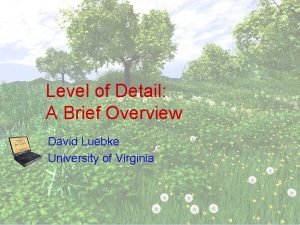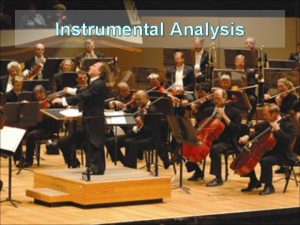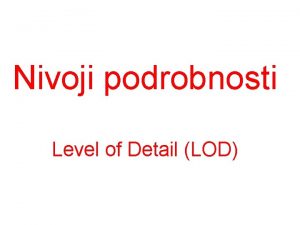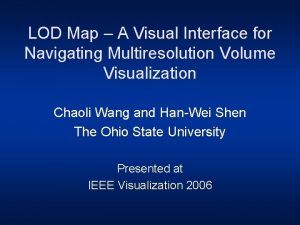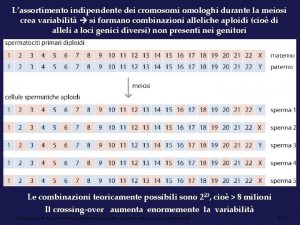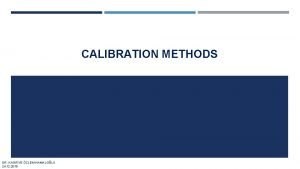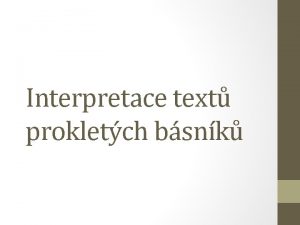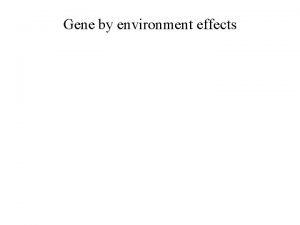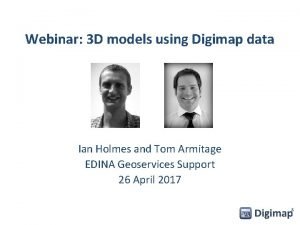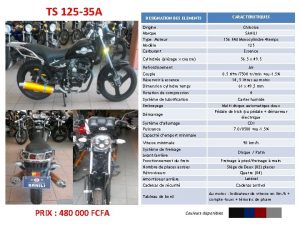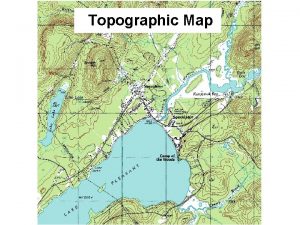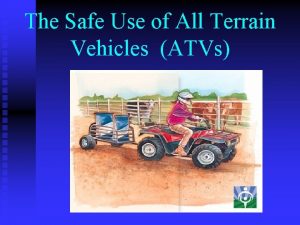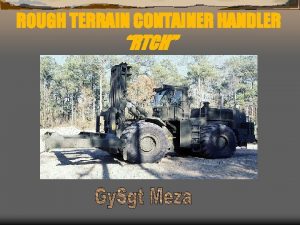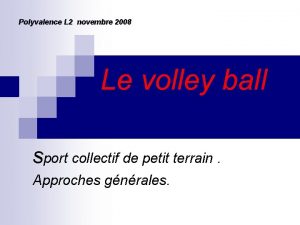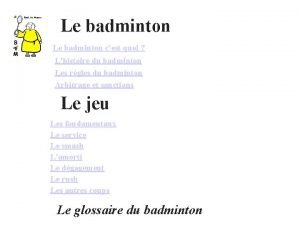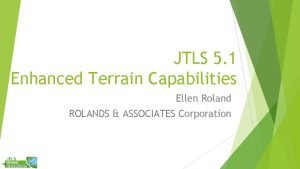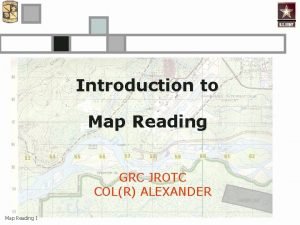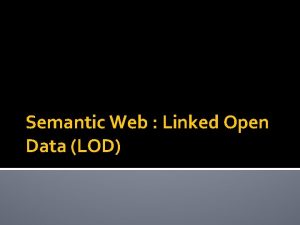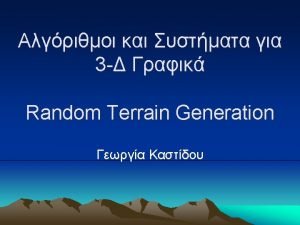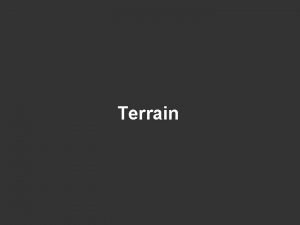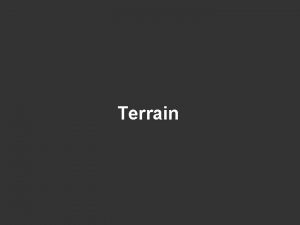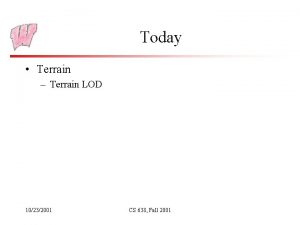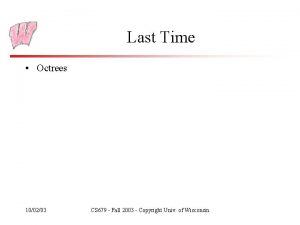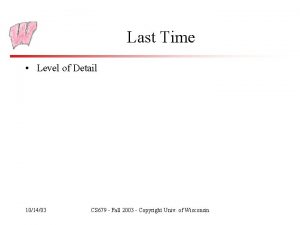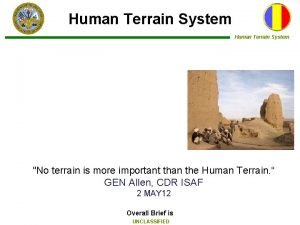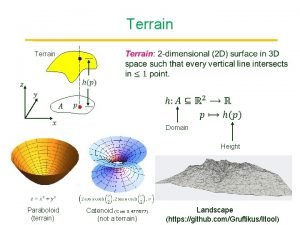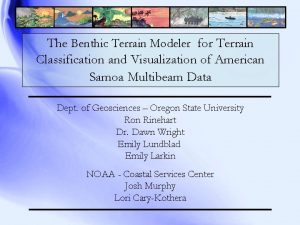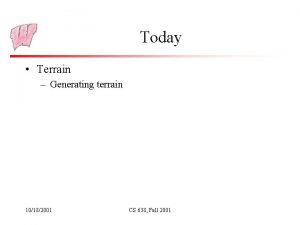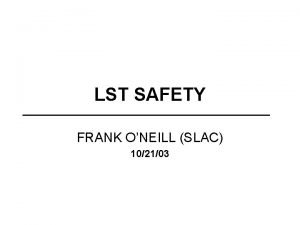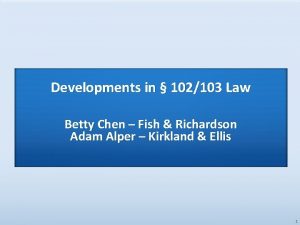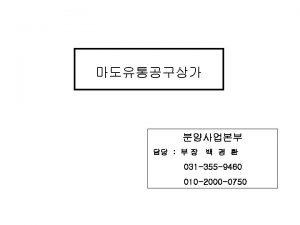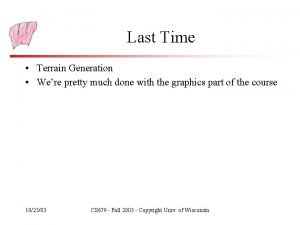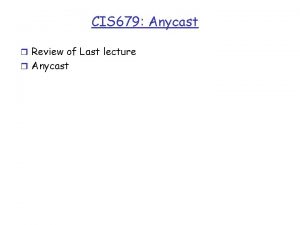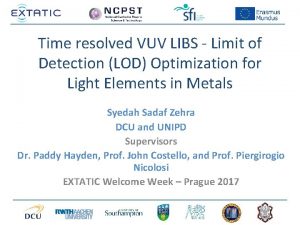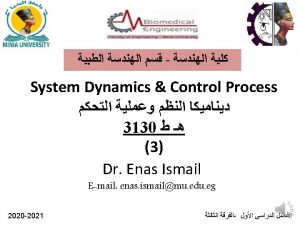Last Time Terrain Dynamic LOD 102103 CS 679





























- Slides: 29

Last Time • Terrain Dynamic LOD 10/21/03 CS 679 - Fall 2003 - Copyright Univ. of Wisconsin

Today • Terrain Generation – Most examples taken from Game Programming Gems 10/21/03 CS 679 - Fall 2003 - Copyright Univ. of Wisconsin

Terrain Generation Methods • Paint the height field (artist generated) • Various pseudo-random processes – – Independent random height at each point Fault generation methods (based on random lines) Particle deposition Fractal terrain from meshes • Triangulated point sample methods • Plenty of commercial tools for terrain generation 10/21/03 CS 679 - Fall 2003 - Copyright Univ. of Wisconsin

Painting Terrain • An artist paints a gray image – Light represents high points, dark is low – The pixels directly give the function values on the grid • The preferred method when good control is required and not too much terrain needs too be generated 10/21/03 CS 679 - Fall 2003 - Copyright Univ. of Wisconsin

Painted Terrain Example Texture Height Color 10/21/03 CS 679 - Fall 2003 - Copyright Univ. of Wisconsin

Surface Attributes • Rather than painting texture and color directly, paint attributes – E. g. Grass, Trees, Water, … – Features can have game-play characteristics: speed of motion, impassable, … • Then automatically generate colors/textures – Care must be taken at the boundaries of the regions • Can also work for the terrain itself – E. g. Maps that have a finite number of possible heights, with ramps between them 10/21/03 CS 679 - Fall 2003 - Copyright Univ. of Wisconsin

Random Processes • The claim is that real terrain looks “random” over may scales • Hence, random processes should generate realistic terrain – The catch is knowing which random processes • Some advantages: – Lots of terrain with almost no effort – If the random values are repeatable, the terrain can be generated on the fly, which saves on storage • Some disadvantages: – Very poor control over the outcome – Non-intuitive parameter settings 10/21/03 CS 679 - Fall 2003 - Copyright Univ. of Wisconsin

Random Points • Randomly choose a value for each grid point – Can make each point independent (don’t consider neighbors) – Can make points dependent on previous points - a spatial Markov process • Generally must smooth the resulting terrain – Various smoothing filters could be used • Advantage: Relatively easy to generate on the fly 10/21/03 CS 679 - Fall 2003 - Copyright Univ. of Wisconsin

Repeatable Random Values • Most “random” number generators on computers are actually “pseudo-random” – Generated by functions that highly de-correlate their input • Standard random number generators produce a sequence of values given some initial seed – Warning: Most implementations are poor, so find your own – Not good enough for on-the-fly terrain, because we don’t know what order the terrain will be required • Hashing functions take a value and transform it into another value with the appearance of randomness – Used in hash tables to transform keys to hash indexes – Great for terrain – Use (x, y) as the key, and hash it to the height 10/21/03 CS 679 - Fall 2003 - Copyright Univ. of Wisconsin

Fault Formation • Claimed to model real fault lines, but not at all like real faults • Process 1: – Generate a random line and lift everything on one side of the line by d – Scale d and repeat – What does the terrain typically look like? • Process 2: – Generate a random line and lift the terrain adjacent to the line – Repeat (maybe with a scale function) – What does the terrain look like? • Smoothing is very important 10/21/03 CS 679 - Fall 2003 - Copyright Univ. of Wisconsin

Fault Formation Example Initial 10/21/03 Smoothed CS 679 - Fall 2003 - Copyright Univ. of Wisconsin

Fault Formation Example 10/21/03 CS 679 - Fall 2003 - Copyright Univ. of Wisconsin

Particle Deposition • Supposed to model lava flow (or glacial drumlins!) • Process: – Drop a particle onto the terrain – Jiggle it around until it it is at most one unit higher than each of its neighbors – Repeat – Occasionally move the drop point around • To do volcanoes, invert everything above a plane • To do sinkholes, invert the hill • To do rows of hills, move the drop point along a line 10/21/03 CS 679 - Fall 2003 - Copyright Univ. of Wisconsin

Particle Deposition Process ? ? In 3 D, more scope for random choices on jiggling particles 10/21/03 CS 679 - Fall 2003 - Copyright Univ. of Wisconsin

Particle Deposition Image 10/21/03 CS 679 - Fall 2003 - Copyright Univ. of Wisconsin

Fractal Terrain • Based on subdivision of a course polygon mesh • Each subdivision adds detail to the mesh in a random way • Algorithm (starting with a triangular mesh): – Split each edge, and shift the new vertex up or down by a random amount – Subdivide the triangles using the new vertices – Repeat • Also algorithms for quadrilateral meshes 10/21/03 CS 679 - Fall 2003 - Copyright Univ. of Wisconsin

Subdivision Method No 1 Note: Works on any triangular mesh - does not have to be regular or have equal sized triangles See my lecture notes from CS 559 for implementation details 10/21/03 CS 679 - Fall 2003 - Copyright Univ. of Wisconsin

Subdivision Method No 2 • Generates a triangle bintree from the top down • Useful for LOD, as we have seen • Ideally, works for right-angled isosceles triangles 10/21/03 CS 679 - Fall 2003 - Copyright Univ. of Wisconsin

Subdivision Method No 3 • Note that the middle of each square is not on an edge, so what is its initial value? • Answers vary 10/21/03 CS 679 - Fall 2003 - Copyright Univ. of Wisconsin

Fractal Terrain Details • The original mesh vertices don’t move, so it defines the overall shape of the terrain (mountains, valleys, etc) • There are options for choosing where to move the new vertices – Uniform random offset – Normally distributed offset – small motions more likely – Procedural rule – eg Perlin noise • If desired, boundary vertices can be left unmoved, to maintain the boundary edge 10/21/03 CS 679 - Fall 2003 - Copyright Univ. of Wisconsin

Fractal Terrain Scaling • Scaling the offset of new points according to the subdivision level is essential – For the subdivision to converge to a smooth surface, the offset must be reduced for each level (to less than half its previous value) – Why? (Intuitively) 10/21/03 CS 679 - Fall 2003 - Copyright Univ. of Wisconsin

Fractal Terrains This mesh probably doesn’t reduce the offset by much at each step. Very jagged terrain http: //members. aol. com/maksoy/vistfrac/sunset. htm 10/21/03 CS 679 - Fall 2003 - Copyright Univ. of Wisconsin

Terrain, clouds generated using procedural textures and Perlin noise http: //www. planetside. co. uk/ -- tool is called Terragen 10/21/03 CS 679 - Fall 2003 - Copyright Univ. of Wisconsin

Terrain, clouds generated using procedural textures and Perlin noise http: //www. planetside. co. uk/ -- tool is called Terragen 10/21/03 CS 679 - Fall 2003 - Copyright Univ. of Wisconsin

Triangulated Point Sets • Start with a set of points that define specific points on the terrain – Tops of mountains, and bottoms of valleys, for example • Triangulate the point set, and then start doing fractal subdivision • What makes a good point set triangulation? 10/21/03 CS 679 - Fall 2003 - Copyright Univ. of Wisconsin

Delaunay Triangulation • A triangulation with the circum-circle property: For every triangle, a circle through its points does not contain any other point • Several algorithms for computing it - look in any computational geometry book Not - points inside this circle 10/21/03 Delaunay CS 679 - Fall 2003 - Copyright Univ. of Wisconsin

Populating Terrain • Coloring terrain: – Paint texture maps – Base color on height (with some randomness) • Trees: – Paint densities, or randomly set density – Then place trees randomly within regions according to density • Rivers (and lakes): – Trace local minima, and estimate catchment areas 10/21/03 CS 679 - Fall 2003 - Copyright Univ. of Wisconsin

Terrain Generation Trade-Offs • Control vs Automation: – Painting gives most control – Fractal terrain next best control because you can always specify more points – Random methods give little control - generate lots and choose the one you like • Generate on-the-fly: – Random points and fractal terrain could be generated on the fly, but fractal terrain generation is quite slow – Tilings can also be generated on the fly 10/21/03 CS 679 - Fall 2003 - Copyright Univ. of Wisconsin

Todo • By Monday, Nov 3, Stage 3 demo • Thursday, Nov 6, Midterm – In class – Material up to and including today’s lecture, but not beyond 10/21/03 CS 679 - Fall 2003 - Copyright Univ. of Wisconsin
 Unity terrain navmesh
Unity terrain navmesh Dynamic lod
Dynamic lod Round off 71
Round off 71 Cs 679
Cs 679 679/12
679/12 Galatians 679
Galatians 679 Difference between lod and sti in cmos
Difference between lod and sti in cmos How to calculate lod score
How to calculate lod score How to calculate lod score
How to calculate lod score Level of detail
Level of detail Lod loq lol
Lod loq lol Lod test
Lod test Lod
Lod Lod
Lod Lod
Lod Lod
Lod Lod
Lod Mne zabloudilou loď
Mne zabloudilou loď Lod score
Lod score Dynamic dynamic - bloom
Dynamic dynamic - bloom Elapsed time
Elapsed time Os terrain 5 dtm
Os terrain 5 dtm Ts designation
Ts designation Minor terrain features
Minor terrain features All terrain vehicle towing capacity 1050lbs
All terrain vehicle towing capacity 1050lbs Rough terrain cargo handler
Rough terrain cargo handler Terrain volleyball dimension
Terrain volleyball dimension Limite terrain badminton simple
Limite terrain badminton simple Enhanced terrain layer
Enhanced terrain layer Spur in map reading
Spur in map reading
